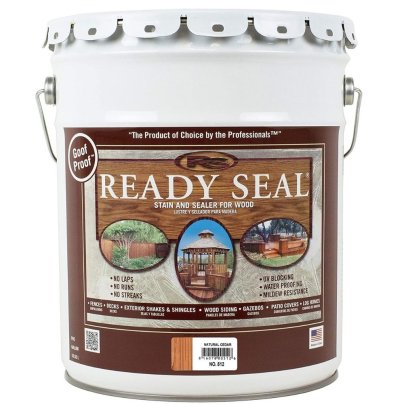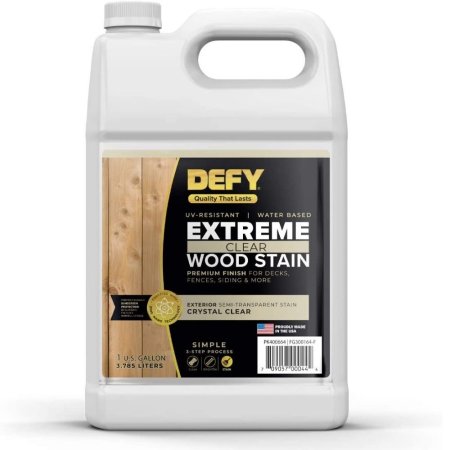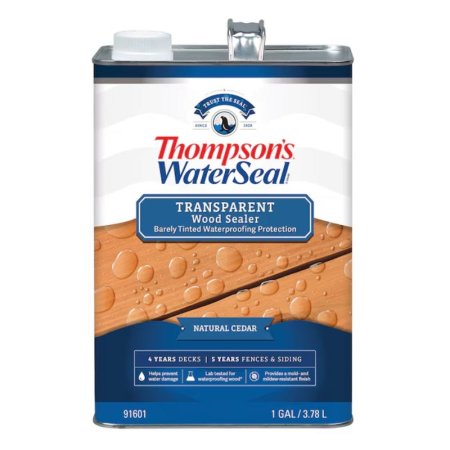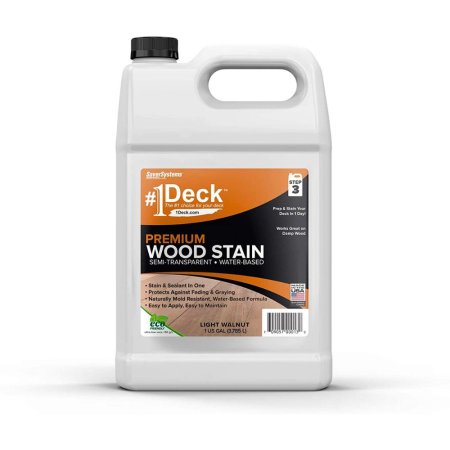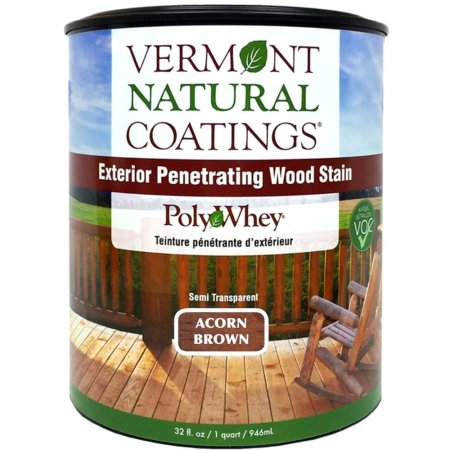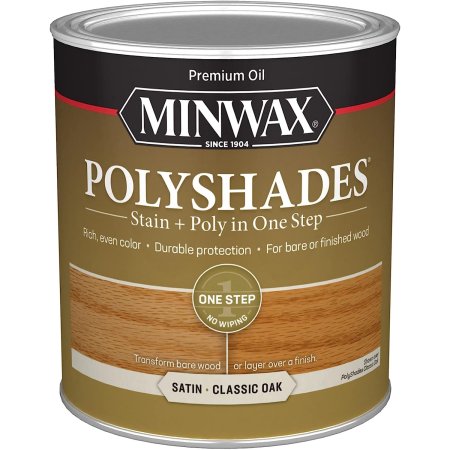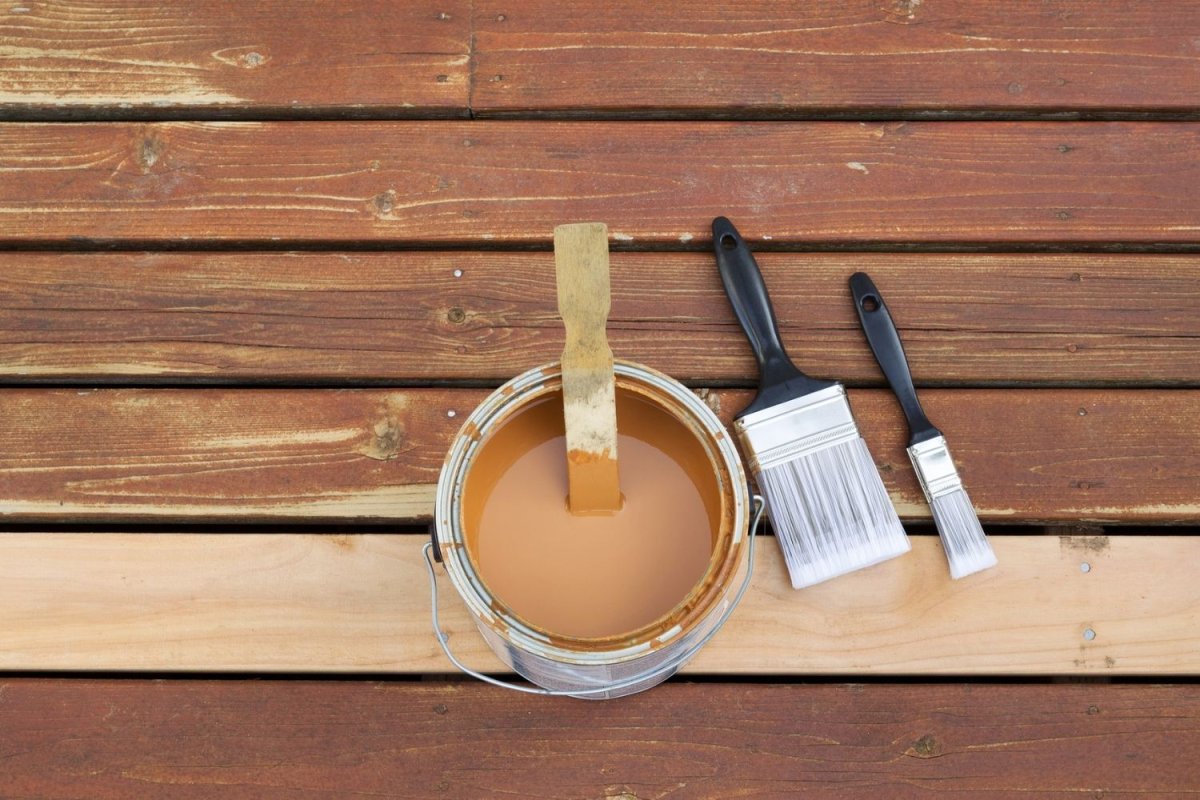
We may earn revenue from the products available on this page and participate in affiliate programs. Learn More ›
Cedar is a beautiful building material. While it can last a long time, even without stain or sealer, it can eventually show signs of wear. Whether it’s a new project or an older surface that might do well with a bit of refreshing, protecting and rejuvenating your cedar structures and furniture with some high-quality stain might be a smart move for optimal longevity.
But with so many products on the market, it might seem impossible to figure out which is the best stain for cedar. This guide helps clear up the differences among stains while pointing out some of the top considerations to keep in mind while shopping.
We recommended the Defy Extreme Semi-Transparent Exterior Wood Stain as our best overall pick because of its versatile indoor/outdoor formula; integrated ultraviolet (UV) and moisture protection; seven color options; and ease of application using a sprayer, brush, or roller.
Keep reading to learn more, and check out some of the other best options on the market, many of which we hands-on tested to ensure they performed as promised.
- BEST OVERALL: Defy Extreme Semi-Transparent Exterior Wood Stain
↓ Jump to Review - BEST BANG FOR THE BUCK: Ready Seal 512 Natural Cedar Exterior Stain
↓ Jump to Review - BEST CLEAR: Thompson’s WaterSeal Transparent Waterproofing Stain
↓ Jump to Review - BEST SEMITRANSPARENT: SaverSystems #1 Deck Premium Semi-Transparent Stain
↓ Jump to Review - BEST WATER-BASED: Vermont Natural Coatings PolyWhey Exterior Stain
↓ Jump to Review - BEST OIL-BASED: Cabot Australian Timber Oil Wood Stain and Protector
↓ Jump to Review - BEST FOR EXTERIORS: Behr DeckPlus Transparent Waterproofing Wood Finish
↓ Jump to Review - BEST FOR FURNITURE: Furniture Clinic Wood Stain
↓ Jump to Review - BEST COLOR SELECTION: Minwax PolyShades Polyurethane Wood Stain
↓ Jump to Review

How We Chose the Best Stain for Cedar
Cedar is such a widely used material, in everything from fencing to furniture, that we felt it important to offer as varied a selection of wood stains as possible. After extensive market research into leading brands and conducting hands-on testing on the majority of these products, we are confident we have put together a range that will satisfy the demands of every task.
While we looked for the most eco-friendly water-based stains where possible, there are still times an oil-based stain is the optimal solution. Wherever possible we chose stains that are easy to use, easy to clean up, and have good fade resistance and durability. We picked stains that allow the original grain warmth to show through, and those that will mask flaws. Value was also a consideration, and there are stains for cedar on our list at a variety of different price points.
Our Top Picks
There is a lot to know about choosing the best stain for cedar. To help make the shopping process go as easily as possible, check out the following list or popular choices. It’s a compilation of some of the best products to stain cedar fences, outdoor furniture, and more.
Best Overall
Defy Extreme Semi-Transparent Exterior Wood Stain
Product Specs
- Oil- or water-based: Water
- Interior/exterior: Both
- Color range: 7
What We Like
- Versatile, easy-to-use stain can be used to enhance and protect, indoors or out
- Uses zinc nano-technology to block UV light and resist stains and mold
- Can be used on pressure-treated lumber and a wide variety of softwoods and hardwoods
What We Don’t Like
- One of the higher-priced stains, and 2 coats are recommended for best results
For cedar decks, fences, siding, or furniture that needs some freshening up or protection, check out Defy’s Extreme Semi-Transparent Exterior Wood Stain. This water-based, quality stain will add a bit of color without blocking out the beauty of the cedar. It comes in six natural finishes, including Natural Cedar, which is meant to enhance the look of cedar surfaces or allow other wood species to mimic the look.
Not only does the Defy Extreme stain enhance cedar surfaces, but it also has some other desirable traits such as UV light protection and low-VOC (volatile organic compounds) content. The recipe includes zinc, the same ingredient found in sunscreen, to prevent the sun’s UV rays from damaging a cedar surface. This stain is easy to apply with a brush, roller, or sprayer, and its water base makes it easy to clean with soap and water.
What our tester says: Tony Carrick, Bob Vila writer and product tester, notes in The Best Exterior Wood Stains that “of all the stains we tested, Defy produced the most well-rounded performance. Defy has a slightly thicker consistency, which made it easier to apply without having to worry about runs or drips. We were able to apply a second coat after just a couple of hours. Defy produced a deep, beautiful finish that accentuated the natural grains in all three types of wood we tested it on with no visible brushstrokes or streaks. It also resisted our attempts to mark it up with a pair of shoes and heavy metal patio furniture. It was among the best against rain, with water beading up on the wood surface during our spray test.”
Get the Defy stain for cedar at Amazon or Walmart.
Best Bang For The Buck
Ready Seal 512 Natural Cedar Exterior Stain
Product Specs
- Oil- or water-based: Oil
- Interior/exterior: Exterior
- Color range: 8
What We Like
- Tough, long-lasting wood stain and sealer at a very competitive price
- Ready to use straight from the can, and doesn’t need a primer
- Low-VOC, streak-free, self-blending formula can be applied with sprayer, roller, or brush
What We Don’t Like
- Needs mineral spirits for cleanup, and it may take several weeks to dry completely
Those looking to stretch their cedar-staining budget as far as it will go may want to check out Ready Seal’s 512 Natural Cedar Exterior Stain. This bucket offers a lower cost per gallon than other stains with similar features, making it a smart choice for budget shoppers.
Ready Seal is an oil-based stain that penetrates and protects cedar surfaces from within. It comes in eight stain colors, with a natural cedar-colored stain variation meant to bring out the beauty of cedar surfaces. It contains UV-protecting particles as well as a mildew-resistant recipe, offering long-lasting protection against more than just water damage. Users can apply Ready Seal with a brush, roller, or sprayer, though cleaning will likely require mineral spirits.
What our tester says: Glenda Taylor, Bob Vila staff writer and product tester, notes in The Best Fence Stain that “we applied the cedar fence stain in a natural cedar tone and really liked the rich color. We applied two coats (as recommended) 45 minutes apart, and then let the board dry for 72 hours. After it dried, we took it outdoors with the rest of the test boards and nailed it to a wooden frame at a 45-degree angle where it received near-direct sunrays. We sprayed it with water, dumped dusty dirt on the wet surface, and let the dirt dry. After the 4-week test period, we power-washed the boards one last time and then let them dry completely before examining them. The board with Ready Seal looked nearly as good as when we first applied the stain.”
Get the Ready Seal stain for cedar at Amazon, Lowe’s, or The Home Depot.
Best Clear
Thompson’s WaterSeal Transparent Waterproofing Stain
Product Specs
- Oil- or water-based: Water
- Interior/exterior: Exterior
- Color range: 3
What We Like
- High-durability coating that exceeds industry-standard ASTM-D4446 for waterproofing wood
- In most cases 1 coat is sufficient, though it can be recoated in just 4 hours
- Seals the wood to provide sun block, mold resistance, and mildew resistance
What We Don’t Like
- Requires careful surface prepping for best results
Protecting cedar surfaces with a water-based stain and sealer might not get any better than with a reliable, old-school product like Thompson’s WaterSeal. This stain comes in three colors, one of which is meant to mimic the color of natural cedar. It can be a good choice for rejuvenating an older cedar deck, fence, or siding surface.
The Thompson’s WaterSeal formula uses a unique recipe to resist color fading, allowing its color to last longer than some other water-based stains. Also, this formula creates a coating that resists mildew and UV damage, preventing graying and fading caused by both of those wood-surface enemies.
What our tester says: Glenda Taylor, Bob Vila staff writer and product tester, notes in The Best Deck Sealers that “we gave the board two coats and then let it dry for 24 hours before continuing our tests. The sealer started to soak in right away, and it imparted a hint of color—not enough to change the look of the wood grain but just enough to enhance it. When sprayed with the hose, water beaded up on the sealed section of the board but soaked into the bare, untreated section. Oncea month in the sun and elements had gone by, we gave the board a good scrubbing. Thompson’s WaterSeal Transparent sealer continued to protect the wood from moisture, as the water beaded up and ran off.”
Best Semitransparent
SaverSystems #1 Deck Premium Semi-Transparent Stain
Product Specs
- Oil- or water-based: Water
- Interior/exterior: Exterior
- Color range: 4
What We Like
- Affordable stain for fence, siding, and deck stain that lets the cedar grain show through
- Quick-drying formula comes ready to use, and it can be applied to all softwoods
- The flat, natural-looking finish is mildew-, fungus-, and mold-resistant
What We Don’t Like
- Careful prep is required, and 2 coats are recommended for full protection
SaverSystems #1 Deck Premium Semi-Transparent Stain might be the product for anyone looking to protect and add a bit of color to an older cedar fence, deck, or siding surface. Its semitransparent finish won’t hide any of the grain or natural beauty, but it can add a bit of color. And with its water-based formula, it will work over any existing stains.
This stain from SaverSystems protects against fading and graying, and it’s available in four colors to bring a bit of pigment to cedar surfaces. It’s also a naturally mildew-resistant formula, preventing fungi and mold from growing on wood surfaces.
What our tester says: Glenda Taylor, Bob Vila staff writer and product tester, notes in our tested guide that “we wet the test board by spraying it with the garden hose and then let it dry until it was just damp. Then we applied a single coat of the cedar wood stain. We tested a semitransparent light-walnut color. It went on well, but we had to wait until the board dried before we could see if it had penetrated uniformly. After we completed the testing, the color of the stain was still vibrant.”
Get the SaverSystems stain for cedar at Amazon or Walmart.
Best Water-based
Vermont Natural Coatings PolyWhey Exterior Stain
Product Specs
- Oil- or water-based: Water-based
- Interior/exterior: Exterior
- Color range: 14
What We Like
- Eco-friendly, low-VOC formula with whey protein is safe to use around wildlife, children, and pets
- Works as a stain and a sealer; provides a waterproof layer and protects against UV damage
- Comes in 14 bright and natural colors to suit a variety of outdoor spaces
What We Don’t Like
- Should not be applied to mahogany, Ipe, and other exotic wood varieties
Water-based stains like this option from Vermont Natural Coatings are more eco-friendly than their oil-based counterparts, making them the ideal choice for homes near wildlife. This low-VOC natural cedar stain uses whey protein as a binder to penetrate the wood and leave behind a waterproof layer for UV and moisture protection while effectively staining cedar fences, furniture, and decks.
This formula also comes in 14 neutral or colorful finish options, including bright green. It can be applied to decks, fencing, raised beds, docks, outdoor furniture, and siding. This stain is also easy to apply with a brush, paint pad, foam brush, or sprayer.
What our tester says: Glenda Taylor, Bob Vila staff writer and product tester, notes in our tested guide that “Vermont Natural Coatings did provide good water resistance during our spray test and deflected scuffs and scratches well. It has a waterlike consistency, which absorbs well into unfinished wood to create a barrier that goes deep into the surface. We also liked its color options, which included hues you don’t typically see in a deck stain, such as green. If you’re serious about using a product that has minimal impact on the environment and don’t mind spending twice as much for it, Vermont Natural Coatings is a great choice.”
Get the Vermont Natural Coatings stain for cedar at Amazon.
Best Oil-based
Cabot Australian Timber Oil Wood Stain and Protector
Product Specs
- Oil- or water-based: Oil
- Interior/exterior: Exterior
- Color range: 4
What We Like
- Combination of oils provide deep penetration into softwood and hardwood decks and outdoor furniture
- Single cedar-staining application produces a rich finish that protects against UV damage and mold and mildew growth
- Excellent coverage, doesn’t crack or peel, and is highly scuff- and fade-resistant
What We Don’t Like
- This is a more labor-intensive product for refinishing a deck
Cedar-surface refinishers looking to give their decks, siding, railings, and outdoor furniture a luxurious finish may want to give Cabot Australian Timber Oil some serious consideration. This product features a blend of linseed and tung oil to penetrate deeply into the wood and protect it from within.
This formula from Cabot protects against water damage as well as UV rays, as it contains iron oxide pigments that protect from the sun. This oil-based stain is available in four colors, including a natural finish to enhance the look of beautifully weathered cedar. There also are some low-VOC variants, which might be preferred for those with particularly sensitive respiratory systems.
What our tester says: Glenda Taylor, Bob Vila staff writer and product tester, notes in our tested guide that “we tested Australian Timber Oil in a warm honey teak tone and liked the look. We brushed on a single coat of stain (as recommended), which penetrated the wood evenly and imparted a natural-looking tone. After 72 hours, the board was ready for testing. After the 4-week test period, the board with Australian Timber Oil looked as good as when we first applied the stain. The color was just as deep and rich as before, making this stain-only product among our personal favorites.”
Get the Cabot stain for cedar at Amazon or Lowe’s.
Best For Exteriors
Behr DeckPlus Transparent Waterproofing Wood Finish
Product Specs
- Oil- or water-based: Water
- Interior/exterior: Exterior
- Color range: 3
What We Like
- Ready-for-use transparent stain provides an exceptionally durable exterior finish
- Environmentally friendly 100 percent acrylic formula requires just soap and water for cleanup
- Prevents water damage and is resistant to mold, mildew, and harmful UV rays
What We Don’t Like
- Preparation is a little fussy, and brush marks or streaks can be visible
Hard-wearing exterior stains for cedar have typically been oil-based, but Behr DeckPlus breaks the mold with a water-based acrylic formula that nevertheless offers outstanding protection for decking, fences, siding, shingles, and outdoor furniture. There are three shades to choose from, and each allows the natural beauty of the wood grain to show through.
Behr transparent stain for cedar seals the wood to protect it from water damage and resist mold, mildew, and UV rays. It should be applied straight from the can, directly onto unsealed wood surfaces, though as always proper preparation is important for a long-lasting finish. Two coats are recommended, and the second coat can be applied within a couple of hours. Full curing takes 72 hours.
Get the Behr stain for cedar at The Home Depot.
Best For Furniture
Furniture Clinic Wood Stain
Product Specs
- Oil- or water-based: Water
- Interior/exterior: Both
- Color range: 12
What We Like
- Easy-to-use, water-based formula from a brand that specializes in furniture care
- Nontoxic, low odor, and dries to a matte finish in just 10 minutes
- Comes in a wide range of semitransparent shades to match most decorative styles
What We Don’t Like
- Stain only; requires wax, varnish, or oil to seal and protect the wood
Furniture Clinic produces a wide range of wood-care products including this collection of 12 water-based stains. They can be used with indoor or outdoor furniture and are eco-friendly, low odor, and nontoxic. The products are easy to apply (use of a foam pad is recommended), and they leave a streak-free finish that penetrates deep into the wood yet dries in as little as 10 minutes.
Furniture Clinic wood stain is suitable for both softwoods and hardwoods. It is water-repellent and UV-resistant, but for full protection an application of wax, varnish, or wood oil is recommended. All of these are available from the Furniture Clinic brand.
Get the Furniture Clinic stain for cedar at Amazon.
Best Color Selection
Minwax PolyShades Polyurethane Wood Stain
Product Specs
- Oil- or water-based: Oil
- Interior/exterior: Interior
- Color range: 28
What We Like
- Available in 28 semitransparent shades, and in either a gloss or satin finish
- Combines penetrative wood stain with tough, long-lasting polyurethane protection
- Can be used on bare wood or over existing finishes without stripping
What We Don’t Like
- Dries in 6 hours; 2 coats are recommended with a light sanding between coats
It can be difficult to find exactly the right color stain for cedar, but the Minwax range goes a long way to solving that problem. There are 28 shades in all, and each comes as either a satin or gloss finish.
The brush-on, oil-based formula does two jobs in one. First it stains the wood, then protects it with a layer of tough polyurethane. It can be applied directly to bare wood, without needing a primer, and can also be used over old stains or varnishes. Stripping is not necessary; all that’s required is a light sanding to provide adhesion. Two coats are recommended, with 6 hours between each.
Get the Minwax stain for cedar at Amazon, Lowe’s, or Ace Hardware.
Jump to Our Top Picks
What to Consider When Choosing a Stain for Cedar
Whether the goal is to enhance cedar with a fresh color or to simply protect your investment, there is a stain that’s up to the task. When selecting the stain, there are a few details to consider when shopping for the right product. The type of stain, the finished look, and the existing coating are all worth keeping in mind. The following sections include these helpful details to make selecting the best stain easier.
Intended Use
Cedar is one of the most flexible and versatile woods available. It does as well outdoors in the elements as it does as a blanket chest or closet lining. As each application encounters different environmental factors, there are different approaches to staining cedar wood.
For interior projects like hope and blanket chests or dressers, any quality interior stain can do the trick. But for the interiors of those chests, dressers, or closets, it’s best to leave the surface untreated. Cedar is naturally bug-repellent, so an unsealed surface will help safeguard blankets and garments stored inside.
When it comes to cedar that’s used outdoors for decks, fences, siding, and furniture, it’s important to use an appropriate stain. These stains are exterior grade, contain sealers, and will protect the wood from decay caused by moisture, UV rays, and fungi.
Base
The best stains for cedar come in a few varieties: water-based, oil-based, and hybrid. These names refer to the liquid base that the stain manufacturer uses for its recipe of pigments and protective particles. It’s important to understand what they are and how they work.
- Water-based stains use good old-fashioned water as the liquid base. These stains are easy to apply and easy to clean up, requiring just a bit of soap and water. They’re also low-VOC (volatile organic compounds), so they’re less likely to bother the user’s respiratory system during application. But they don’t penetrate very deeply, and they might not last as long.
- Oil-based stains, such as those that use paraffin-, synthetic-, and plant-based oils, soak into the wood deeply, rejuvenating the fibers and protecting the surface from the inside. They can really improve the grain’s visual “pop,” enhancing the look of the wood. But they have a much higher VOC content, so they can require the use of a respirator to avoid irritation, even outdoors. Also, cleanup requires mineral spirits.
- Hybrid stains combine a bit of both worlds. Generally, these stains use water as the main base but also contain penetrating oils to soak into the wood. They’re lower in VOCs than oil-based stains and generally clean up with mineral spirits. However, hybrid stains aren’t wildly popular yet.
Film-Forming vs. Penetrating Stain
Stain products will protect cedar decks, fences, furniture, and siding differently, depending on the type of stain. For instance, a water-based product might create a film or shell over the stain, while an oil-based product might soak into the grain to protect it from within.
- Penetrating stains work their way into the grain of woods like cedar. While in there, they rejuvenate the wood fibers and strengthen them. They allow moisture from within the wood to escape but keep rain, snow, and other elements from penetrating. They’re long lasting and may last around 5 years before restaining is necessary. However, they don’t do a great job of hiding damage, blemishes, or mismatched wood.
- Film-forming stains will create a barrier over the exterior of the cedar, keeping water from passing through. Because they coat the surface of the wood, they can be excellent at covering blemishes and mismatched grain, but they don’t last as long as penetrating stains.
Opacity
Depending on their amount of opacity or transparency, stains have the ability to hide blemishes, enhance grain, or simply protect without drawing attention to themselves. They come in varying levels of transparency.
- Transparent stains, or clear stains, won’t do much beyond strengthening the wood fibers and protecting the wood against the elements. Many DIYers find this level of transparency perfect for cedar if they want to let the natural silvery color of weathered cedar shine through.
- Semitransparent stains are mostly clear but often tinted with a pigment or color to enhance the overall look of the surface. These stains don’t hide blemishes or mismatched grain well, but they do offer protection and a bit of rejuvenation for cedar surfaces that are still in good condition.
- Semisolid stains are all about adding a new hue to the wood while offering protection. These stains also will hide the grain and character of a cedar fence or deck, so they’re generally not preferred for cedar surfaces.
- Solid stains will hide a wood surface’s grain, blemishes, and knots. Solid stains help visually blend repaired boards and other imperfections completely, leaving behind a uniform surface.
Existing Coating
If you’re staining a new deck, new siding, or a freshly erected fence, any exterior stain can be used. But when restaining or refinishing a cedar surface, the previous coating needs to be considered when choosing a product.
If a previously finished cedar surface has an oil-based stain, there’s the choice of using oil-based or water-based stain on top. The oil will be able to penetrate the wood, and water-based stains will adhere to the surface.
But for surfaces already treated with water-based stains, another water-based product needs to be used. Previous water-based stains won’t allow oil-based stains to penetrate, causing them to pool on the surface and offering very little protection.
Added Protection
An exterior stain’s primary purpose is to keep moisture from penetrating wood surfaces and causing damage from swelling, buckling, warping, and more. But some of the best stains for cedar offer more protection.
Cedar is already fairly rot- and mildew-resistant, but using a stain that contains mildewcide will help ensure that cedar surfaces don’t succumb to the damage of fungi.
And while many people enjoy using their cedar deck on bright sunshiny days, the sun is not a deck’s best friend. For cedar decks, it’s worth looking for a stain with extra UV protection, as these stains will protect cedar surfaces from the damage caused by intense UV rays.
Application
Applying the best stain for cedar is fairly straightforward, but a little prep work and knowledge can go a long way toward ensuring a quality outcome. Here are some tips to help the job go smoothly.
- Prepare the surface. Using an exterior wood cleaner and a scrub brush, give the surface a thorough cleaning. Quickly sand off any standing fibers after the deck dries.
- Apply the stain. Using a roller and brushes, apply the stain to the entire surface. Work in small sections to avoid missing spots or dry edges. If using a sprayer, it’s possible to work in larger sections, but be sure to overlap the edges of each section.
- Keep a wet edge. As with any stain or paint project, be sure to maintain a wet edge to avoid lap marks or dry spots.
- Apply a second coat if necessary. Wait for the stain to dry before determining if it needs another coat. A sealer can be applied over the top of penetrating stains, but most exterior-grade products already contain sealers.
FAQs
Even with this extensive background on cedar stains and review of some of the top products, there might be some additional questions. The following is a collection of frequently asked questions about stains for cedar, so an answer to your question may be listed below.
On its own, cedar will last a long time, resisting rot, bugs, and mold. Over time, the color will turn into a pleasant silvery gray. To protect that surface without taking away from its natural beauty, use a clear or transparent stain.
Cedar is naturally weather-resistant, but it cannot be weatherproofed. Its water resistance can be enhanced with a stain and sealer to protect it from water penetration.
Painting versus staining is a matter of preference, but since most people use cedar because of its natural beauty, painting it or staining with a solid deck stain will hide its characteristics.
Before applying the stain, you’ll want to sand cedar in small circular motions to remove previous paint, stain, or treatment and reveal the wood’s natural grain. Ensure that all debris and dust are wiped from the surface after sanding and then apply stain as directed by the manufacturer.
Oil-based stains are better for cedar than their water-based counterparts since they penetrate the wood effectively and keep the cedar protected from UV and moisture exposure.
Cedar is a softwood like pine, but it stains very easily and evenly due to its natural, porous fibers. Stains can penetrate into the surface to waterproof wood against rain, snow, and ice. However, cedar must be lightly sanded for the sealant to adhere correctly.
The rule of thumb is to use two coats for completely stained cedar wood. This allows the stain to penetrate the surface completely and provide improved color and finish.
Cedar does not naturally resist rotting and needs to be sealed and stained every 2 to 3 years. This ensures the cedar is completely protected from UV and moisture damage while keeping the wood looking new and vibrant.

